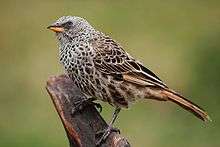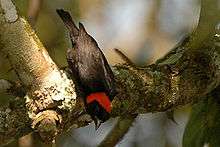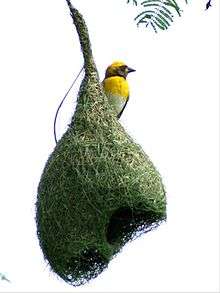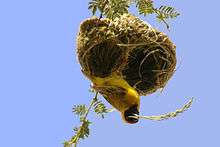Ploceidae
| Weavers | |
|---|---|
 | |
| Male southern masked weaver (Ploceus velatus) | |
| Scientific classification | |
| Kingdom: | Animalia |
| Phylum: | Chordata |
| Class: | Aves |
| Order: | Passeriformes |
| Suborder: | Passeri |
| Family: | Ploceidae Sundevall, 1836 |
| Genera | |
|
See text. | |

-_Male_W_IMG_0709.jpg)








The Ploceidae, or weavers, are small passerine birds related to the finches.
Biology
These are seed-eating birds with rounded conical bills, most of which are from Sub-Saharan Africa, with fewer species in tropical Asia. A few species have been introduced outside their native range.[1] The weaver group is divided into the buffalo, sparrow, typical, and widow weavers. The males of many species are brightly coloured, usually in red or yellow and black, some species show variation in colour only in the breeding season.
Weaver birds, also known as weaver finches, get their name because of their elaborately woven nests (the most elaborate of any birds'), though some are notable for their selective parasitic nesting habits. The nests vary in size, shape, material used, and construction techniques from species to species. Materials used for building nests include fine leaf-fibers, grass, and twigs. Many species weave very fine nests using thin strands of leaf fiber, though some, like the buffalo-weavers, form massive untidy stick nests in their colonies, which may have spherical woven nests within. The sparrow weavers of Africa build apartment-house nests, in which 100 to 300 pairs have separate flask-shaped chambers entered by tubes at the bottom. Most species weave nests that have narrow entrances, facing downward.
Many weaver species are gregarious and breed colonially.[1] The birds build their nests together for protection, often several to a branch. Usually the male birds weave the nests and use them as a form of display to lure prospective females. The weaver bird colonies may be found close to water bodies. They sometimes cause crop damage, notably the red-billed quelea, reputed to be the world's most numerous bird.[2][3]
Phylogeny
These species are not closely related to the sparrows (Passeridae) nor to the Emberizidae, according to Luis Allende and colleagues.[4][5]
Species list
- Genus Bubalornis
- White-billed buffalo weaver, Bubalornis albirostris
- Red-billed buffalo weaver, Bubalornis niger
- Genus Dinemellia
- White-headed buffalo weaver, Dinemellia dinemelli
- Genus Sporopipes
- Speckle-fronted weaver, Sporopipes frontalis
- Scaly-feathered weaver, Sporopipes squamifrons
- Genus Ploceus
- Black-chinned weaver, Ploceus nigrimentus
- Baglafecht weaver, Ploceus baglafecht
- Bertram's weaver, Ploceus bertrandi
- Slender-billed weaver, Ploceus pelzelni
- Loango weaver, Ploceus subpersonatus
- Little weaver, Ploceus luteolus
- Lesser masked weaver, Ploceus intermedius
- Spectacled weaver, Ploceus ocularis
- Bannerman's weaver, Ploceus bannermani
- Bates's weaver, Ploceus batesi
- Black-necked weaver, Ploceus nigricollis
- Black-billed weaver, Ploceus melanogaster
- Strange weaver, Ploceus alienus
- Bocage's weaver, Ploceus temporalis
- Cape weaver, Ploceus capensis
- Eastern golden weaver, Ploceus subaureus
- Holub's golden weaver, Ploceus xanthops
- Príncipe weaver, Ploceus princeps
- Orange weaver, Ploceus aurantius
- Golden palm weaver, Ploceus bojeri
- Taveta weaver, Ploceus castaneiceps
- Southern brown-throated weaver, Ploceus xanthopterus
- Northern brown-throated weaver, Ploceus castanops
- Kilombero weaver, Ploceus burnieri
- Rüppell's weaver, Ploceus galbula
- Heuglin's masked weaver, Ploceus heuglini
- Northern masked weaver, Ploceus taeniopterus
- Vitelline masked weaver, Ploceus vitellinus
- Southern masked weaver, Ploceus velatus
- Katanga masked weaver Ploceus katangae
- Lufira masked weaver, Ploceus ruweti
- Tanzanian masked weaver, Ploceus reichardi
- Village weaver, Ploceus cucullatus
- Giant weaver, Ploceus grandis
- Speke's weaver, Ploceus spekei
- Fox's weaver, Ploceus spekeoides
- Vieillot's black weaver, Ploceus nigerrimus
- Weyns's weaver, Ploceus weynsi
- Clarke's weaver, Ploceus golandi
- Black-headed weaver, Ploceus melanocephalus
- Juba weaver, Ploceus dichrocephalus
- Golden-backed weaver, Ploceus jacksoni
- Cinnamon weaver, Ploceus badius
- Chestnut weaver, Ploceus rubiginosus
- Golden-naped weaver, Ploceus aureonucha
- Yellow-mantled weaver, Ploceus tricolor
- Maxwell's black weaver, Ploceus albinucha
- Nelicourvi weaver, Ploceus nelicourvi
- Sakalava weaver, Ploceus sakalava
- Streaked weaver, Ploceus manyar
- Baya weaver, Ploceus philippinus
- Asian golden weaver, Ploceus hypoxanthus
- Finn's weaver, Ploceus megarhynchus
- Black-breasted weaver, Ploceus benghalensis
- Dark-backed weaver, Ploceus bicolor
- Preuss's weaver, Ploceus preussi
- Yellow-capped weaver, Ploceus dorsomaculatus
- Usambara weaver, Ploceus nicolli
- Olive-headed weaver, Ploceus olivaceiceps
- Brown-capped weaver, Ploceus insignis
- Bar-winged weaver, Ploceus angolensis
- São Tomé weaver, Ploceus sanctithomae
- Yellow-legged weaver, Ploceus flavipes
- Compact weaver, Ploceus superciliosus
- Genus Malimbus
- Red-crowned malimbe, Malimbus coronatus
- Cassin's malimbe, Malimbus cassini
- Gola malimbe, Malimbus ballmanni
- Rachel's malimbe, Malimbus racheliae
- Red-vented malimbe, Malimbus scutatus
- Ibadan malimbe, Malimbus ibadanensis
- Red-bellied malimbe, Malimbus erythrogaster
- Blue-billed malimbe, Malimbus nitens
- Crested malimbe, Malimbus malimbicus
- Red-headed malimbe, Malimbus rubricollis
- Genus Anaplectes
- Red-headed weaver, Anaplectes rubriceps
- Genus Brachycope
- Bob-tailed weaver, Brachycope anomala
- Genus Quelea
- Cardinal quelea, Quelea cardinalis
- Red-headed quelea, Quelea erythrops
- Red-billed quelea, Quelea quelea
- Genus Foudia
- Red fody, Foudia madagascariensis
- Red-headed fody, Foudia eminentissima
- Comoros fody, Foudia eminentissima
- Forest fody, Foudia omissa
- Mauritius fody, Foudia rubra
- Seychelles fody, Foudia sechellarum
- Rodrigues fody, Foudia flavicans
- Genus Euplectes
- Yellow-crowned bishop, Euplectes afer
- Fire-fronted bishop, Euplectes diadematus
- Black bishop, Euplectes gierowii
- Black-winged red bishop, Euplectes hordeaceus
- Northern red bishop or orange bishop, Euplectes franciscanus
- Southern red bishop or red bishop, Euplectes orix
- Zanzibar red bishop, Euplectes nigroventris
- Golden-backed bishop, Euplectes aureus
- Yellow bishop, Euplectes capensis
- Fan-tailed widowbird, Euplectes axillaris
- Yellow-mantled widowbird, Euplectes macroura
- White-winged widowbird, Euplectes albonotatus
- Red-collared widowbird, Euplectes ardens
- Marsh widowbird, Euplectes hartlaubi
- Montane widowbird, Euplectes psammacromius
- Long-tailed widowbird, Euplectes progne
- Jackson's widowbird, Euplectes jacksoni
- Genus Amblyospiza
- Thick-billed weaver, Amblyospiza albifrons
| Wikimedia Commons has media related to Ploceidae. |
| Wikispecies has information related to: Ploceidae |
References
- 1 2 Craig, Adrian (2010). "Family Ploceidae (Weavers)". In del Hoyo, J.; Elliott, A.; and Christie, D. A. Handbook of the Birds of the World 15. Barcelona: Lynx Edicions. pp. 74–197.
- ↑ Fry, C.H. & Keith, S. (2004) The birds of Africa vol. VII. Christopher Helm, London
- ↑ BirdLife International (2012). "Quelea quelea". IUCN Red List of Threatened Species. Version 2012.1. International Union for Conservation of Nature. Retrieved 16 July 2012.
- ↑ Allende, Luis M.; Rubio, Isabel; Ruíz-del-Valle, Valentin; Guillén, Jesus; Martínez-Laso, Jorge; Lowy, Ernesto; Varela, Pilar; Zamora, Jorge; Arnaiz-Villena, Antonio (2001). "The Old World sparrows (genus Passer) phylogeography and their relative abundance of nuclear mtDNA pseudogenes" (PDF). Journal of Molecular Evolution 53 (2): 144–154. PMID 11479685. Archived from the original (PDF) on 21 July 2011.
- ↑ Arnaiz-Villena, A; Gómez-Prieto P; Ruiz-de-Valle V (2009). "Phylogeography of finches and sparrows". Nova Science Publishers. ISBN 978-1-60741-844--3.
- Videos, photos and sounds - Internet Bird Collection